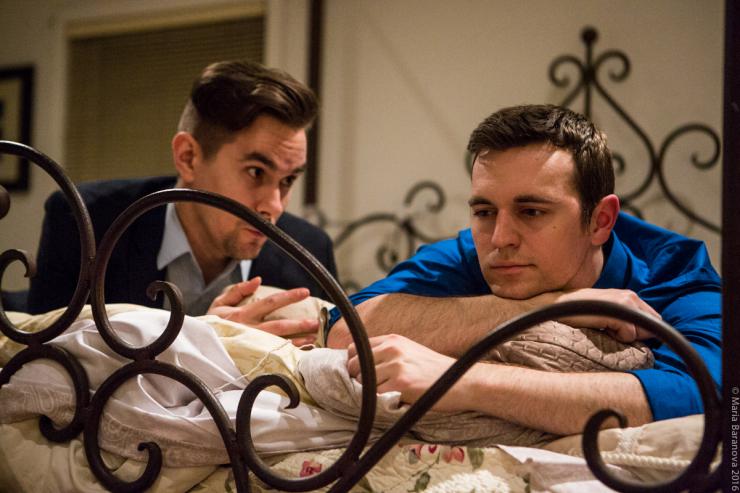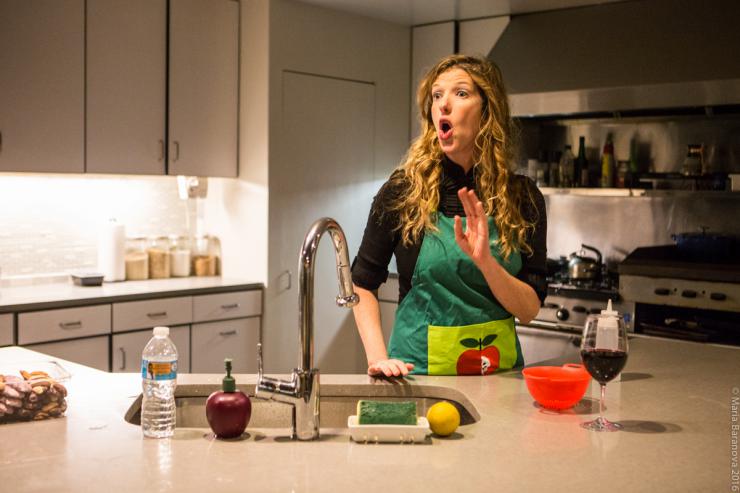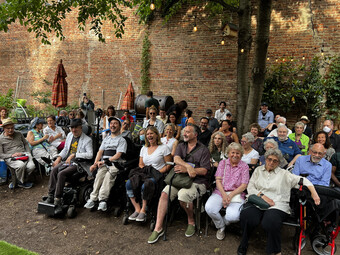Stage Managing Immersive, Site-Specific, and Participatory Theatre
“Sophia, would you make my bed?” No, I was not asking my stage manager for a personal favor. I was, as artistic director of This Is Not A Theatre Company, asking stage manager Sophia Lana Cohen Smith to get the bed ready for our site-specific performance Versailles 2016, which took place in a New York City apartment—in this case, mine. Since I didn’t want to sleep in sheets the cast jumped around in, nor did they want to jump around in sheets I had slept in, we had a completely separate set of bedclothes for the show, which needed to be set up by our stage manager. To be honest, it felt so odd to ask Sophia to make my bed that I usually did it myself. But my hesitation made me wonder about all the unique things a stage manager of site-specific, immersive, and/or participatory theatre has to do. What do the stage manager’s duties tell us about this kind of work?

When This Is Not A Theatre Company staged Pool Play in an actual natatorium at Waterside Plaza, Sophia had to inflate the boat we rowed around the pool, set out several sets of towels for the actors, set out bath mats for the audience to sit on (they sat on the edge of the pool with their feet in the water), and temporarily dismantle the doorbell so it wouldn’t ring in the middle of the performance. All while wearing only the special shoes allowed on the pool deck. All stage managers call places—but how many of them call places in a sauna?
In immersive and participatory theatre, the props are often eaten, touched, and used by audience members. For Versailles 2016 Sophia heats the spanakopita we serve to audiences in the living room, puts all the other hors d’oeuvres we serve to audiences on the coffee table, lays out wine and water on the dining room table, and sets out the cake we serve to audiences in the kitchen scene. She makes coffee in the kitchen so the scent of coffee will pervade the apartment, and sprays both bathrooms with different perfumes so audiences have a multi-sensory experience. For Versailles 2016 Sophia needs to set props in two bathrooms, the bedroom, the living room, and the kitchen—necessitating five pre-show check-lists, one for each room.

Sophia points out that she often has to “manage” audiences as well as “the stage”—noting where they are, where they are going, tracking their journey through the space, and occasionally “herding” them in the correct direction.

Because the set is everywhere in immersive theatre, Sophia is never separated from actors or audiences by a booth; she always has to play a character. When she pours ginger ale into champagne flutes for the cast to drink during Versailles 2016, she pours one for herself and sips from it throughout the show as though she too is a party guest. Sophia points out that she often has to “manage” audiences as well as “the stage”—noting where they are, where they are going, tracking their journey through the space, and occasionally “herding” them in the correct direction.
In fact, Sophia points out that her blocking notation often includes notes about when and how audiences move. “I take down the gist of the blocking or the ideal blocking, and then I watch for the ways actors and audiences adapt to the particularities of a given situation.” Actors have to improvise new staging configurations based on where audience members place themselves in the scene from night to night, and Sophia has to be alert to the constantly shifting landscape. “It is never the same twice,” she notes. “That is one of the joys of site-specific theatre.”
In participatory theatre the stage manager’s cues are often based on when and how audiences interact with various aspects of the show. In A Serious Banquet, which was based on a dinner party Picasso threw for painter Henri Rousseau in 1908 Paris, audiences were invited to experience various pieces of art before the dinner started. There was a recorded still life scene between a bottle and a vase, and Sophia would cue that recording whenever someone came within a foot of the still life. A phone would ring, and when an audience member picked up the phone, they would hear Guillaume Apollinaire recite a poem. The cue for the phone to ring was whenever someone came within two feet of it. Apollinaire was played by an absinthe glass with a hidden speaker. Audiences would pass “him” around, and “introduce him” to other audience members and “he” would recite poetry. Sophia had to watch the absinthe glass, and cue the glass to recite poetry whenever it was handed to a new person. As a result, she “never called a show the same way twice.”
Readymade Cabaret was based on Duchamp’s notions of readymade art and John Cage’s ideas of chance. We performed twenty of twenty-eight scenes: the scenes we performed, and the order in which we performed them were determined by the audience rolling dice. Sophia’s cues were determined by the order of the scenes, which is to say by the same roll of the dice. Readymade Cabaret included an audience-created Dada poem, tweet dances (one-minute dances improvised in response to tweets written by the audience at the show), and a sculpture made of all the props used over the course of the evening. Sophia’s stage manager’s report included a photo of the “scene board” where we listed all the scenes we had performed, a photo of the Dada poem, a photo of the sculpture, and a list of the tweets that had been used.
Coming at stage management from a directing perspective helps me understand the end goal of all the choices, so that while managing everything I have a good grasp of where things need to land. —Sophia Lana Cohen
Sophia pointed out that one of the big differences between site-specific theatre and a production that has a run in a dedicated space is that you have to load in and out every day. For Pool Play, Sophia and I would lug the wet towels and bath mats from the gym back to my apartment to wash and dry; she would deflate the boat and store it in a gym locker; and she would roll the waterproof speaker back to my house for safekeeping between shows. Sophia doesn’t just have a pre-show checklist, she has a break-down and packing list: which props and set pieces go in which rolling suitcase so we can transport them from site to site. “I enjoy figuring out how to transport everything we need in the most efficient way,” she says.
Sophia is a director in her own right, and Co-Artistic Director (with Mikey Craighead) of Dirty Dishes Theatre Company.
“Coming at stage management from a directing perspective helps me understand the end goal of all the choices, so that while managing everything I have a good grasp of where things need to land. At the same time, stage managing site-specific theatre has made me a more flexible and open director, because the textbook solutions don’t seem like they are the best solutions.”
Dirty Dishes will embark on their first site-specific piece this summer: they are theatricalizing the experience of being around a campfire listening to ghost stories.
“Working with TINATC has made me very interested in site-specific theatre in a way I hadn’t been before. I am very interested in the audience as a significant part of the experience. The cliché that a show isn’t finished until the audience arrives become literally true in this kind of participatory and site-specific work, because the audience becomes part of the piece. Every night TINATC actors have hilarious stories of how the audience changed the show, and that has made me interested in what incorporating the audience in the piece does for theatre.”
Click here for more information about Versailles 2016.








Comments
The article is just the start of the conversation—we want to know what you think about this subject, too! HowlRound is a space for knowledge-sharing, and we welcome spirited, thoughtful, and on-topic dialogue. Find our full comments policy here
I'd like add something to this article: I think it's time we started treating stage managers like the artists they are. The reason Sophia is such a good stage manager is that she is a great artist.
Thank you for posting this! My theatre company, Found Stages, recently produced an immersive piece inspired by Amy Tan's "The Joy Luck Club" that had three audience members sit at a table with a single actor. There were four tables, each with a different character. Audiences rotated in and out of the production as tables became available. Because everyone played a hand of Mah Jong, the timing could vary each time. Our Production Manager Kara Procell managed the production more like a restaurant host, with our ASM providing feedback throughout the night that could sound very similar to courses of a meal. That's in addition to the tea she brewed and cookies she set out to give to audience members waiting to participate in the performance. Innovative stage managers are invaluable in this kind of work. Thank you for highlighting what they do!
Innovative stage managers are essential: to SM this kind of material you need a unique combination of organization, flexibility, an ability to watch all parts of the room at the same time, and an in-depth understanding of the artistic and practical goals of the production. We couldn't function without Sophia!!